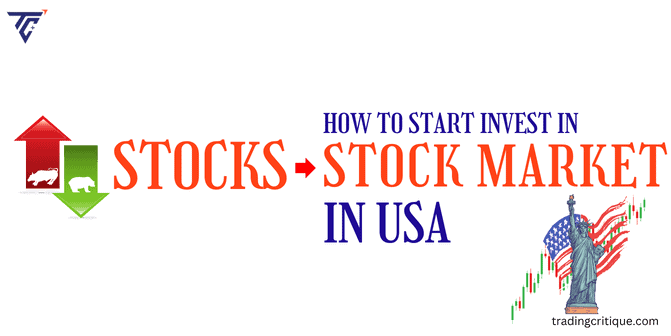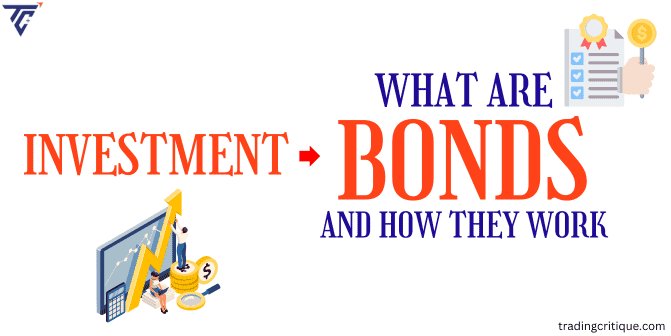How to Start Investing in Stock Market? 7 Easy Tips for Beginners
The stock market is the act of buying and selling shares of ownership in companies. It is also called equity or shares. When you buy a stock, you own a part of the company.

Thinking about investing in the stock market, you are not alone. This guide helps you to learn the basics of investing, considering your time horizon, getting started with a little money, and how to invest in stocks in the USA for beginners.
Quick Insights
When you buy a stock, you become a tiny owner of that company. Investing always has some risk, so only use money you can afford to lose.
It provides a step-by-step guide, including setting goals, determining risk tolerance, choosing an investment amount, selecting a brokerage account, and picking investments.
Before you invest, learn more about the company and the stock market. A financial advisor can give you personalized advice based on your situation.
How to invest in the US stock market?
How to start investing in stocks? Investing in the stock market is the most powerful tool to make more money. Investing is accessible even with a small amount of money. There are some risks involved in it. Before investing in the stock market, consult with a financial advisor for personalized guidance based on your criteria.
To start investing in stock, the step-by-step procedure is given below:
- Set your goals and do research
- Evaluate your risk appetite
- Choose the investment amount
- Select the investment account
- Find your broker
- Select your investments
- Manage stock portfolio
Set your goals and do research
Before start investing in stock, the first step is to set your investing goals and do your research. Find how long you achieve the goal you set. If you set a long-term goal, you will have safe and steady growth with little risk. The more time you give to grow, the less risk you need to take.
After that, you need to know about the basics of stock and safest investing through an online resource. Beginners always focus on lower-risk investments to gain profits.
Evaluate your risk appetite
The next step is to determine your risk tolerance. For beginners with a shorter time horizon, a lower risk tolerance might be appropriate. Check how much risk you are comfortable with your pre-defined goal. This will keep you stressed during stock market ups and downs.
Some investors prefer high risk and high reward, while others prefer lower risk and lower reward. Finding out your risk tolerance level helps you to keep a portfolio.
Choose the investment amount
How much should I invest in stocks? Beginners should only invest what they can afford to lose without affecting their financial stability. It belongs to the affordability of the investors. You can select the minimal amount that emphasizes investment strategy for beginners.
How to invest in stocks for beginners with little money? Beginners can benefit from regular investing with a smaller amount every month. The amount can be $25 (small amount) or $100 (slightly larger amount) depending on your budget. Check with your chosen brokerage for their minimum investment amount.
Select the investment account
The next step is to open a brokerage account with a low-fee broker since you are looking to invest a small amount. Some brokers offer commission-free trading, educational resources, easy-to-use interfaces, and tutorials which are very helpful for beginners.
Beginners should only invest what they afford to lose. When considering how to invest in stocks in the USA, beginners should prioritize low-risk investments like stocks mutual funds or ETFs to start. These offer diversification, which helps reduce your risk.
There are different types of brokerage accounts available to consider for novices. Some of them are retirement accounts, standard brokerage accounts, and Robo-advisor accounts.
Retirement accounts: It offers tax advantages that motivate saving for the future. It can be of two types. They are traditional IRA and Roth IRA. You can choose the best retirement account depending on your tax situation and future.
In a traditional IRA, you can get tax benefits upfront when you contribute. In a Roth IRA, you grow your money tax-free and withdraw it tax-free in retirement.
Standard brokerage account: This is the most common account type. In this account type, you can buy and sell stocks mutual funds, ETFs, bonds, etc.
Robo-advisor account: This account type is a good option for beginners. It is an automated investment platform. It creates and manages a portfolio based on your goals and risk tolerance.You can always consult a financial advisor to choose an investment account.
Find your broker
Once you have decided to open a brokerage account, the next step is to find a reputable broker that suits your needs. Some of the things that need to be considered before choosing a good broker. They are listed below:
- Fee’s structure
- Account minimum
- Investment option
- Customer service
- Research tools and educational resources
Select the broker which has minimal fees of inactivity, commission-free trading, and account fees. Beginners often benefit from brokers with low fees, especially if you are starting with a small amount of money.
Confirm that the broker offers good investment options such as stocks, mutual funds, ETFs, and fractional shares. Make sure that the broker has a very minimum amount for regular investing.
Verify if the broker’s customer service handles inquiries and has a good reputation. You can see the platforms that have sufficient research tools and educational resources.
Select your investments
After choosing your broker and funding your account, it’s time to select what to invest in. The most challenging one for most beginners is deciding the individual stocks for investing. There are many options for investing for beginners with limited capital.
With a little money, you can get started investing in the stock market through stocks, mutual funds, and ETFs which can offer diversification. It helps to reduce your risk and volatility. Do research before investing your money in it.
Many online brokers offer research tools to help with this. If you are starting with a small amount, see if a broker allows you to purchase a fractional share of stocks. This allows you to invest in companies whose stocks are high.
Manage stock portfolio
Once you have chosen your investment, it is important to manage your portfolio successfully. Keep yourself updated on financial markets and trends. Many brokers provide tools and new feeds to help you to stay informed.
Track your portfolio performance regularly. Many brokers offer these services. Once you have planned for a long-term investment strategy, stick to it and market downs.
By following these steps, staying disciplined consulting a financial advisor if needed, you can gradually build your wealth over time.
What should I look for when investing in stocks?
Some of the key factors you should look at when buying stocks and selling stocks. They are listed below:
Company analysis
You become a partial owner of a business when you buy a stock. It is advisable to choose a company which we are familiar with. It helps us to see the company’s financial statements including earnings, revenue, and profitability.
If you know about the company, it will help you to avoid false information. You must either do some research or find a different company, to understand how a business makes money.
Check the price-to-earnings ratio (P/E)
Once the company analysis is done, the next step is to look at the price-to-earnings ratio. It compares a stock’s share price to its earnings. The P/E ratio can be a useful metric, but it is important to consider other factors and keep your investment time horizon in mind.
To determine whether a company has good value in the industry, you must check the P/E ratio. The P/E ratio is a measure of how much investors are willing to pay for each dollar of annual earnings. If the ratio is low but it is growing fast, your investment will increase and vice versa.
Beta risk analysis
Beta is used to calculate the risk involved and the last five years’ performance in the stock market when compared to other markets. A company has a high beta if its performance is different from the S&P 500.
High-beta stocks might be suitable for a high-risk tolerance but not for someone risk-averse.There is a higher risk when the stock has a beta above 1.
A beta below 1 means the stock price tends to be less volatile. Beta is based on past performance. Future results are not guaranteed.
Dividend history and yield
Before buying stocks, another step is to examine the company’s dividends and yield. The dividend yield is a small bonus the company gives you each year (percentage of stock price).
You can see a higher income if the dividend yield is high. Sometimes higher dividend yield is used to attract investors to a company. It may lead to trouble for the investors. A high yield might not be beneficial if the stock price is falling.
Study charts and determine trends
The next step is to learn charts and identify trends. There are different charts available in the stock market. There are different types of charts available. They are candlesticks, lines, and bar charts used for various purposes.
It can be used for both fundamental and technical purposes. It is used to see the stock historical data. Charts are often used in technical analysis, focusing on price movements and patterns.
With charts and trends, you can be able to know which stock has good performance and go with that. By considering these factors and doing your research, you can make more informed investment decisions and potentially improve your returns over the long term.
By considering factors like company fundamentals, P/E ratio, beta risk tolerance, and dividend history. Consulting with a financial advisor can be beneficial, especially for beginners. You can make informed decisions about stocks with your investment goals.
Conclusion
Before investing, spend some time to understand the risk tolerance and do research with different options. For beginners, start investing with a small amount of money in the stock market. Be patient, seek professional advice if needed, and stay disciplined while investing.
By following the steps mentioned above, you will be building a strong foundation for your financial future. Once you have done your research, you are ready to invest in the stock market and potentially make money over time!
Pro Tip
Open your brokerage account today and start investing in your future! Explore our trusted forex broker platform, you will find useful information on stocks, bonds, CFDs, and forex to enhance your investment strategy.
Frequently asked questions
1. How do beginners enter stocks?
- Setting your investment goals and research
- Find how much you invest and risk tolerance
- Determine your investing style
- Select your investment account
- Master the cost of investing
- Select your suitable broker
2. When should a beginner buy stocks?
It is difficult to find the timing of the stock market to trade. The best time of day to buy stocks is usually in the morning (after the market opens). Market timing is difficult and focusing on long-term investing is more reliable for beginners.
Buying a quality stock and holding it for the long term is a better approach for beginners.
3. How much money can you make from stocks in a month?
Investing in the stock market is a balance between risk and reward. There is no limit to how much you could make, and you could lose money. So, it is about how much risk you take.
4. How often should I invest in stocks?
The good timing for investing in stocks depends on the goals, skills, and risk tolerance. The most common approach for beginners is monthly investing, where you invest a fixed amount of money every month. This helps average out the cost of stocks over time.
5. Should I invest or save?
Choosing between investing or saving depends on how soon you want the money back. Investing is a long-term goal; it has the potential for higher returns than a savings account but with some risk.
A savings account is a short-term goal (within 3 to 5 years) with easy access to cash and it has low risk with low returns.
6. How long does it take to make money from stocks?
There is no guaranteed timeframe for making money in the stock market. It may take at least a year to make money when you select a stock from a good company.
In short-term investing, day trading requires good experience, and knowledge, and can be risky. While profits can be made quickly, losses can also happen fast.

Subscribe to
Our Newsletter
Latest Posts
How to Trade Forex | Learn 6 Strategies and Tips
Discover the world of forex trading with our comprehensive guide. Learn essential...
Read MoreFP Markets Review 2024: Everything You Need To Know
Founded in 2005, FP Markets is a leading online broker renowned for...
Read MoreHow to Invest in Ethereum in 2024 – Simple Guide for Beginners
Ethereum is a decentralized blockchain platform that enables smart contracts, enabling secure,...
Read MoreIs Cryptocurrency a Safe Investment? What You Need To Know
Investing in cryptocurrency involves selecting the right cryptocurrency and securely storing your...
Read MoreHow to Read Forex Charts for Beginners • Simple Methods
Traders look for the currency pair price movements, their patterns, and their...
Read MoreBonds: What it is, Types of Bonds & How they Work (2024 guide)
Are you seeking for safe investment with predictable returns? Our 2024 guide...
Read MoreWhat are The Best Crypto Trading Strategies for Beginners in 2024?
Unsure about choosing the best trading strategies for beginners in 2024? This...
Read MoreForex Pairs: How They Work, How To Read, Examples
Forex pairs are combinations of two different currencies that are traded in...
Read MoreBest Ways to Avoid Losses in Forex Trading
Foreign Exchange – Forex market is the world’s largest financial market in...
Read More









